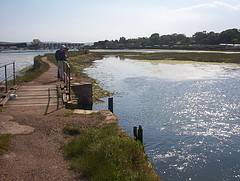Barker planning review: wildlife safe in our hands..?
- Complaining about the Mainland - 17th August, 2024
- New island designation – is it just greenwash? - 26th April, 2024
- Police and Crime Commissioners – a solution or a problem? - 21st April, 2024
Readers will not need The Ranger to draw their attention to the radical proposals made via HM Treasury in the Barker review of the planning system. The Guardian explains:
Under proposals put forward by the economist Kate Barker, planning permission will be easier to obtain for new airports, supermarkets and other large developments. Ms Barker, a member of the Bank of England monetary policy committee, was commissioned by the Treasury to look at ways of reforming the planning system to help tackle housing shortages and promote economic growth.
Previously, this sort of research – if not this sort of result – might have been expected from the erstwhile Department of the Environment, Transport and The Regions (DETR). It is not news that for many years the Treasury has been itching to get around those pesky environmentalists, who have been sheltering behind John Prescott’s considerable bulk.

Now that Mr Prescott is driving off towards the sunset, Mr Brown is stepping forward. DETR is no more and it’s no great surprise that this report arrives as soon as it does, and that it recommends resolving the perceived conflict between developers and environmentalists in such a pointed way. If development is being thwarted by environmental constraints, Barker seems to argue that the way to resolve the conflict is simply to ease those constraints. Maybe it really is that simple. The Ranger, fresh from several years working in a planning authority and with experience of numerous planning applications constrained by environmental concerns, does not think so. Good development can be achieved, often to the benefit of biodiversity and landscape. Environmental constraints are one way to help this happen, not to hinder it. But just as there are some developments that are of over-riding importance, there are also some habitats and species of over-riding importance, and they need to be conserved. In this context we need to accept that for some proposed developments, no means no – it does not mean that we should rewrite the rules until we get the answer we want. On another point, if the desired end result is good and sustainable decision-making, there is a need for local concerns to be given more consideration, preferably in advance of application, rather than the contrary. Taking power over their local environment away from people is rarely a popular or successful move in the long term, because they will not endorse the decisions taken. Interestingly, there was an Ipsos MORI poll commissioned for the review. It stated that 71 per cent of respondents said land with important or endangered wildlife should be safeguarded. Land with scenic value came second with 54 per cent, and green spaces in towns and cities third with 47 per cent. The RSPB interpreted this, rather optimistically as “Barker planning review backs safeguards for wildlife sites“. Simon Marsh, Head of Planning and Regional Policy at the RSPB said:
People believe that wildlife is important both in the countryside and in towns and cities. Kate Barker has accepted that environmentally important land should be properly protected and that designated land, such as Sites of Special Scientific Interest and Special Protection Areas, do this extremely well.
The Ranger is concerned about this interpretation, too, for a simple reason. Environmentally important land is not the same thing as designated land. Designated areas are not enough. Wildlife and landscape exists everywhere, and it must be conserved and enhanced everywhere – yes, even in the most intensive developments. Consigning it to protected areas is ultimately to divorce us from it, and to lose it. Working on the Isle of Wight brings some unusual insights into land management and designations. In particular, the Area of Outstanding Natural Beauty. The designation is scattered, almost at random, across the Island. It is universally acknowledged that a few areas within the AONB are not worthy of the designation, and that many outside it are worthy. So in some ways the boundary of the designation acts as a hindrance rather than help, insofar as those area outside of the AONB are concerned. But in over 40 years since it was designated nobody has dared realign the boundary, nor are they ever likely to do so because of the huge complexity and controversy involved in doing so. And a lot has changed in 40 years.

Designations of all sorts, as Barker well understands, by themselves are simply not flexible enough to respond to the wider needs of today’s society, either to allow development or to conserve and enhance biodiversity. The RSPB and Kate Barker are right to point out that the existing protected landscape and habitat system works well – it does, up to a point. But the designated areas can be only a part of the answer, never the whole thing. If everything outside of that system is to be sacrificial we shall lose far more than we have ever managed to conserve.
